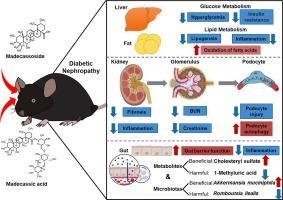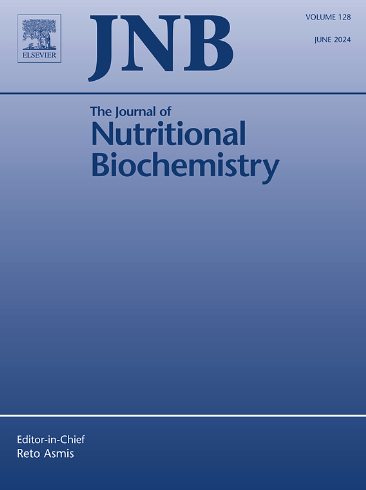Madecassoside and madecassic acid mitigates diabetic nephropathy via podocyte autophagy and gut microbiota in mice
IF 4.9
2区 医学
Q1 BIOCHEMISTRY & MOLECULAR BIOLOGY
引用次数: 0
Abstract
Diabetic nephropathy (DN) is a common microvascular complication of diabetes with limited treatment options available. Madecassoside (MA) and madecassic acid (MCA) exhibit various pharmacological activities, while their effects on DN remain elusive. Here, we found that MA and MCA treatment mitigated insulin resistance, alleviated metabolic disorders, and attenuated systemic inflammation in high-fat diet- and streptozotocin-induced DN mice. In addition, MA and MCA administration alleviated the biochemical indicators for kidney function and reduced renal inflammation and fibrosis, thereby mitigating the progression of DN. These renal protective effects were partly mediated by the activation of podocyte autophagy. Moreover, MA and MCA protected the integrity of the gut barrier and altered the microbial composition and their metabolites, resulting in an enrichment of beneficial bacteria and metabolites and a reduction of the pathogenic bacteria and harmful metabolites. Therefore, MA and MCA alleviated DN by activating podocyte autophagy and regulating microbiota dysbiosis.

蓖麻皂苷和蓖麻酸通过小鼠足细胞自噬和肠道微生物群减轻糖尿病肾病。
糖尿病肾病(DN)是糖尿病常见的微血管并发症,治疗方案有限。麻籽皂苷(MA)和麻籽酸(MCA)表现出多种药理活性,但其对DN的作用尚不明确。在这里,我们发现MA和MCA治疗减轻了高脂肪饮食和链脲佐菌素诱导的DN小鼠的胰岛素抵抗,减轻了代谢紊乱,并减轻了全身炎症。此外,给药MA和MCA可改善肾功能生化指标,减轻肾脏炎症和纤维化,从而缓解DN的进展。这些肾保护作用部分是由足细胞自噬的激活介导的。此外,MA和MCA保护了肠道屏障的完整性,改变了微生物组成及其代谢物,导致有益细菌和代谢物的富集,致病菌和有害代谢物的减少。因此,MA和MCA通过激活足细胞自噬和调节微生物群失调来减轻DN。
本文章由计算机程序翻译,如有差异,请以英文原文为准。
求助全文
约1分钟内获得全文
求助全文
来源期刊

Journal of Nutritional Biochemistry
医学-生化与分子生物学
CiteScore
9.50
自引率
3.60%
发文量
237
审稿时长
68 days
期刊介绍:
Devoted to advancements in nutritional sciences, The Journal of Nutritional Biochemistry presents experimental nutrition research as it relates to: biochemistry, molecular biology, toxicology, or physiology.
Rigorous reviews by an international editorial board of distinguished scientists ensure publication of the most current and key research being conducted in nutrition at the cellular, animal and human level. In addition to its monthly features of critical reviews and research articles, The Journal of Nutritional Biochemistry also periodically publishes emerging issues, experimental methods, and other types of articles.
 求助内容:
求助内容: 应助结果提醒方式:
应助结果提醒方式:


